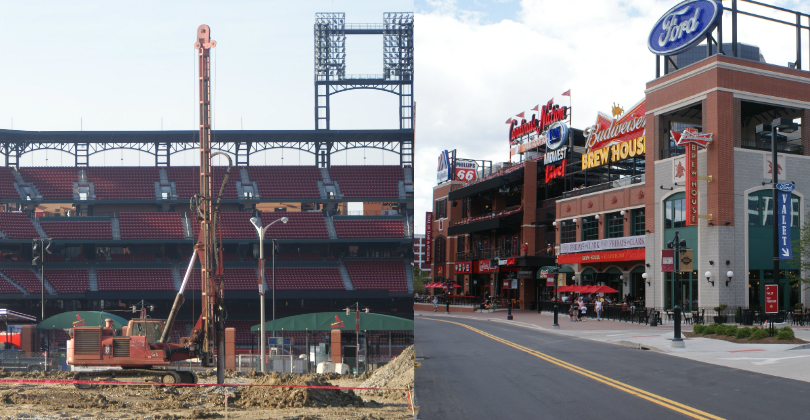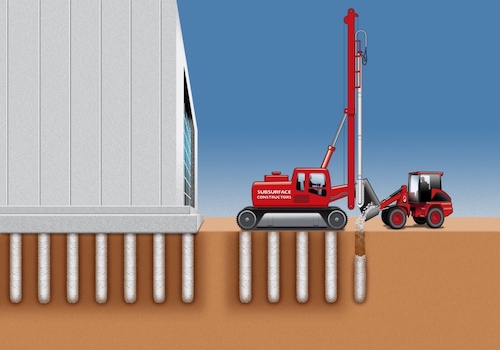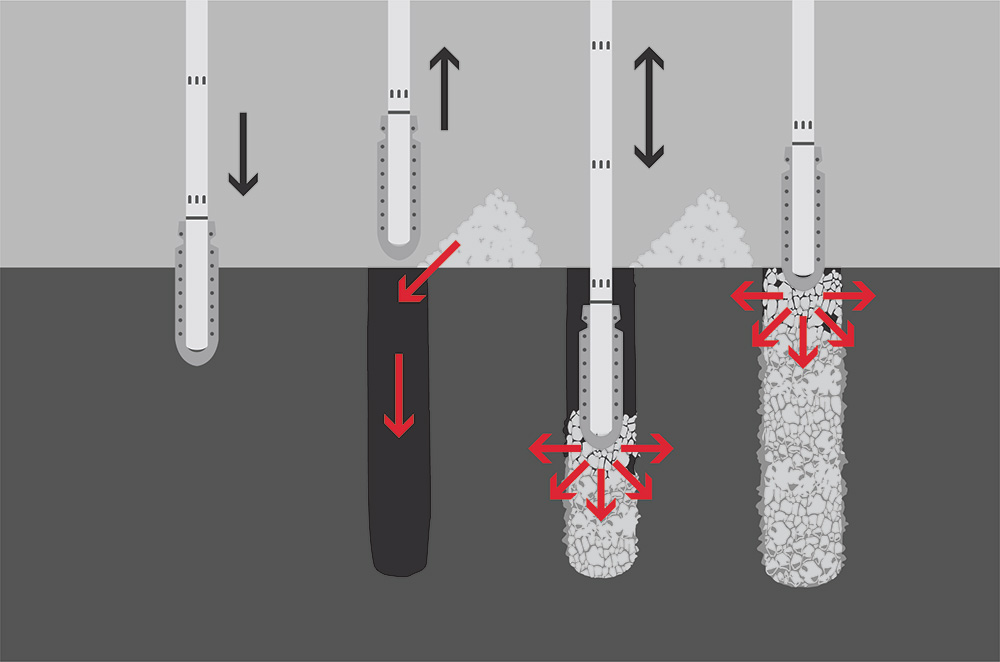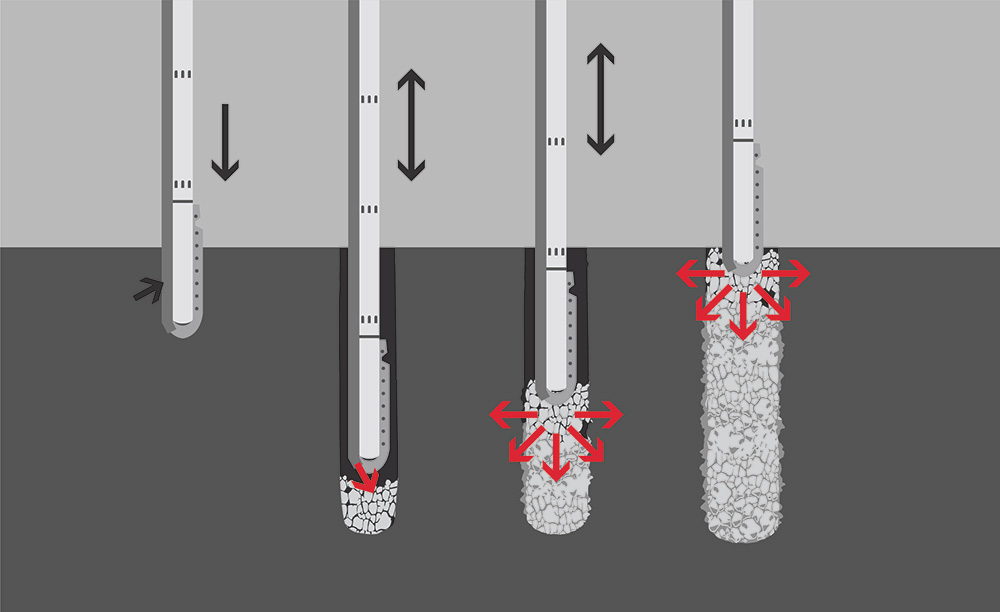Aggregate piers are columns of compacted stone installed in groups in poor soil to increase bearing pressure and mitigate settlement under structural footings.
The phrase aggregate piers may be used to describe either a rammed pier or a vibrated pier, also called a vibro stone column (VSC). Aggregate piers are often the most economical option for constructing in soft soils because of the materials used (stone is cheaper than concrete), the speed of construction (specialty contractors can often install 40 to 60 aggregate piers per day) and the treatment depth.
Typical bearing pressures using aggregate piers are in the range of 4,000 pounds per square foot (psf) to 6,000 psf, but could be higher depending on the proportions of the existing soil.
Subsurface Constructors installs 620 aggregate piers for Ballpark Village. Subsurface Constructors has designed and installed aggregate piers for more than 900 projects.
Vibro Stone Columns (VSCs) / Aggregate Piers offer a low cost alternative to:
- Rammed piers
- Over-excavation and replacement
- Site pre-loading
- Deep foundations
Advantages of Vibro Ground Improvement methods include:
- Minimal to no spoils
- Quick installation
- In-house engineering and design
- Continuous, automated quality control
Download Our Guide to Aggregate Piers Design & Cost
Desktop guide to aggregate pier ground improvement
Learn about your options, your costs and bidding out your foundation construction project.
What is a Geopiers® System / Rammed Aggregate Pier®?
Aggregate piers may also be referred to as vibro stone columns, Vibropiers® or Geopiers® Rammed Aggregate Piers. Rammed Aggregate Piers® are a proprietary system developed by the Geopier® company.
Aggregate piers are made up of 20-to-36-inch diameter columns of highly compacted stone, constructed in groups within a footing or loaded area. The stone replaces or displaces the existing soft soil, resulting in a footing area with both stone columns and existing soils. That combination can produce bearing pressures up to three or four times the bearing pressures of the in situ (previously present on-site) soils. The high modulus columns also help significantly reduce the anticipated settlement of the loaded area.
Rammed Aggregate Piers® vs. Vibro Stone Columns
There are two primary types of aggregate piers: Rammed Aggregate Piers® and vibrated aggregate piers (or vibro stone columns).
The primary difference between the two is the way they’re constructed. Rammed Aggregate Piers® are constructed by pre-drilling a hole, putting aggregate into lifts, and then tamping or ramming the lifts down into the hole. The process is repeated until the pre-drilled hole is filled with highly compacted aggregate.
Rammed Aggregate Piers® Disadvantages
Rammed Aggregate Piers® typically require a graded stone to reach maximum compaction, while vibrated piers use clean stone — stone that is all roughly the same size. Both rammed and vibrated piers can provide bearing pressures in the range of 4,000 pounds per square foot (psf) to 6,000 psf or higher, depending on the soil makeup.
The main concerns owners have regarding different types of aggregate piers are one, that they provide the structure with the necessary support, and two, choosing the least expensive option.
How Do Vibrated Aggregate Piers Work?
Vibrated aggregate piers use large vibratory probes that vibrate at a high frequency to compact granular material. The probes can be inserted in a predrilled hole, or using some unique rigs, crowded into the ground to laterally displace the soft soil and create an open column. The stone can then be poured into the hole and compacted in lifts with the vibratory probes.
At Subsurface Constructors, we use several such rigs to install stone columns without pre-drilling. As a result, we are able to minimize or even eliminate the generation of spoils. Because this technique eliminates a substantial part of the ground improvement process, vibrated piers that are installed without pre-drilling are often the most cost-effective approach. Of course, in some soil types, it’s necessary to pre-drill. This is usually the case with stiff soils and some fill soils.
VSC/Aggregate Pier Top Feed Installation
When the stone for aggregate piers is dumped from the ground surface, the process is called “top-feed installation,” especially when referring to vibro installation methods. The top-feed technique is used when the soils are relatively stable, and a pre-drilled or probed hole will stay open during the stone placement and compaction process.
VSC/Aggregate Pier Bottom Feed Installation
When the existing soils are unstable, such as in silty or granular soils, a bottom-feed installation technique can be used. In this case, the stone is tremied to the bottom of the hole through the compaction device, and the tool is not removed from the hole until the aggregate pier is complete.
Aggregate Piers Installation Video
Subsurface Constructors installs vibro stone columns foundation for Southern Illinois University Transportation Center in Murphysboro, IL.
Vibro Stone Columns: A Low Cost Alternative
For over 115 years, Subsurface Constructors has been a leading innovator in designing and constructing deep foundations. Subsurface Constructors has the expertise to design and construct a ground improvement program that greatly improves the bearing capacity and settlement performance of a soft-soil site, while still allowing for spread footing construction. We boast the largest fleet of stratacaster and mast-mounted vibro rigs in the U.S. These mobile rigs allow for vibro stone columns to be installed via a top or bottom fee method while being continuously monitored by our on-board computer system.
Get a Complete Analysis of Aggregate Pier Applicability to your Ground Improvement Project
Contact Subsurface Constructors today for a prompt and thorough analysis with experienced aggregate pier engineers, and get your project on the fast-track to completion.
Written by: Lyle Simonton, P.E. , LEED® AP
Lyle Simonton is the Director of Business Development for Subsurface Constructors of St. Louis, MO, with offices in Boston, Cleveland, and Minneapolis. Lyle holds a BS in Geological Engineering from Missouri University of Science and Technology (formerly the University of Missouri-Rolla) and a MS degree in Civil (Geotechnical) Engineering from the University of Illinois – Champaign Urbana. He is a registered professional engineer in Missouri.
Lyle is a member of ASCE and DFI, and actively participates on the Soil/Ground Improvement Committees for both the ASCE Geo-Institute and the Deep Foundations Institute. He is a Past – President of the ASCE St. Louis Section and currently serves as its Membership Chairperson. Lyle has been an active member of the St. Louis GeoInstitute Chapter throughout his career. He is also a member of the Professional Advisory Board for the Civil and Environmental Engineering Department at Southern Illinois University at Carbondale.






